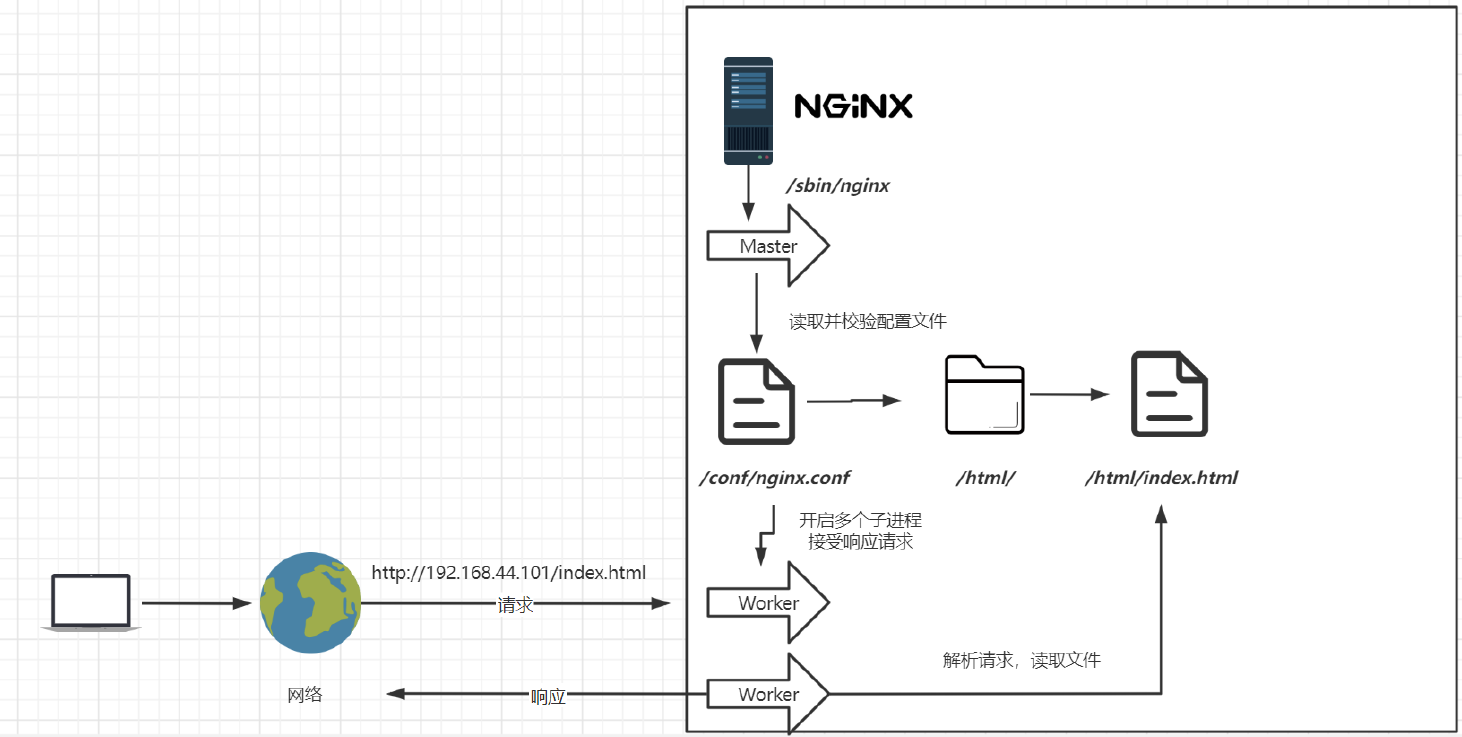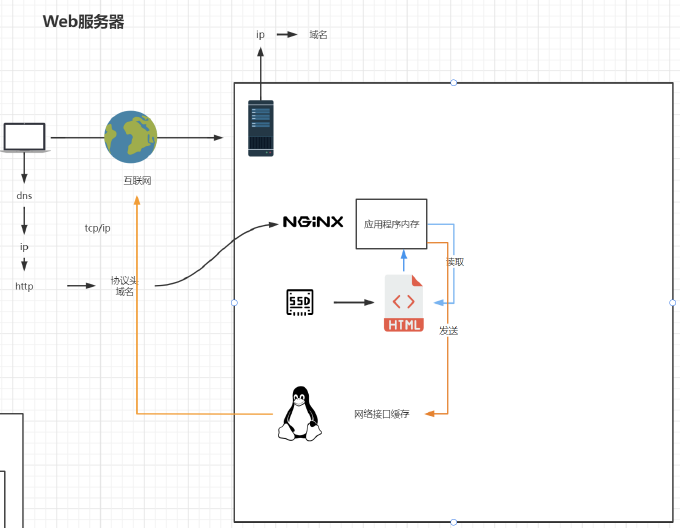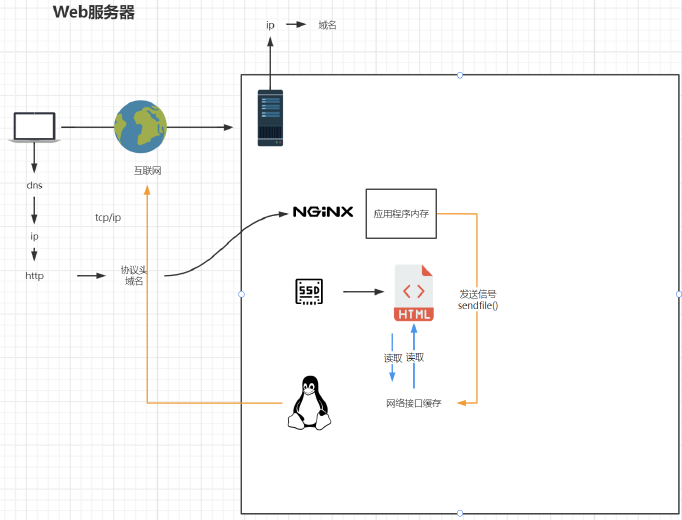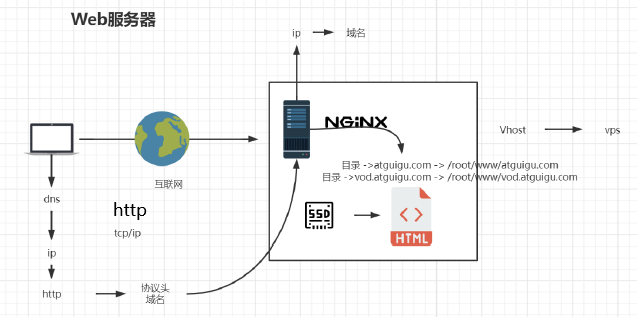文章和代码已经归档至【Github仓库:https://github.com/timerring/front-end-tutorial 】或者公众号【AIShareLab】回复 nginx 也可获取。
文章目录
目录结构
进入Nginx的主目录有如下文件夹
client_body_temp conf fastcgi_temp html logs proxy_temp sbin scgi_temp uwsgi_temp
其中以_temp结尾的文件夹是用来存放运行过程中的临时文件了。
其他主要的文件夹是:
- conf:用来存放配置文件相关
- html:用来存放静态文件的默认目录 html、css等
- sbin:nginx的主程序
- logs:存储各种日志,例如access记录访问的相关记录,error记录报错的记录,nginx.pid记录服务的pid号,即进程id号。
基本运行原理

一共有多个进程,其中有一个主进程Master负责读取,校验配置文件。
而子进程Worker则是相应对应的访问等请求。
Nginx配置与应用场景
首先重点是Nginx的配置文件 nginx.conf ,其中有很大一部分的注释配置,这里先关注nginx所需的最小配置。
#user nobody;
worker_processes 1;
#error_log logs/error.log;
#error_log logs/error.log notice;
#error_log logs/error.log info;
#pid logs/nginx.pid;
events {
worker_connections 1024;
}
http {
include mime.types;
default_type application/octet-stream;
#log_format main '$remote_addr - $remote_user [$time_local] "$request" '
# '$status $body_bytes_sent "$http_referer" '
# '"$http_user_agent" "$http_x_forwarded_for"';
#access_log logs/access.log main;
sendfile on;
#tcp_nopush on;
#keepalive_timeout 0;
keepalive_timeout 65;
#gzip on;
server {
listen 80;
server_name localhost;
#charset koi8-r;
#access_log logs/host.access.log main;
location / {
root html;
index index.html index.htm;
}
#error_page 404 /404.html;
# redirect server error pages to the static page /50x.html
#
error_page 500 502 503 504 /50x.html;
location = /50x.html {
root html;
}
# proxy the PHP scripts to Apache listening on 127.0.0.1:80
#
#location ~ \.php$ {
# proxy_pass http://127.0.0.1;
#}
# pass the PHP scripts to FastCGI server listening on 127.0.0.1:9000
#
#location ~ \.php$ {
# root html;
# fastcgi_pass 127.0.0.1:9000;
# fastcgi_index index.php;
# fastcgi_param SCRIPT_FILENAME /scripts$fastcgi_script_name;
# include fastcgi_params;
#}
# deny access to .htaccess files, if Apache's document root
# concurs with nginx's one
#
#location ~ /\.ht {
# deny all;
#}
}
# another virtual host using mix of IP-, name-, and port-based configuration
#
#server {
# listen 8000;
# listen somename:8080;
# server_name somename alias another.alias;
# location / {
# root html;
# index index.html index.htm;
# }
#}
# HTTPS server
#
#server {
# listen 443 ssl;
# server_name localhost;
# ssl_certificate cert.pem;
# ssl_certificate_key cert.key;
# ssl_session_cache shared:SSL:1m;
# ssl_session_timeout 5m;
# ssl_ciphers HIGH:!aNULL:!MD5;
# ssl_prefer_server_ciphers on;
# location / {
# root html;
# index index.html index.htm;
# }
#}
}
最小配置
worker_processes
worker_processes 1; 默认为1,表示开启一个业务进程,对应服务器的物理cpu的内核数,一个cpu内核对应一个worker_processes。当然也可以加大worker_processes 个数,但是对于同一个cpu来说需要调度,效率反而下降了。
events模块下
worker_connections
worker_connections 1024; 单个业务进程可接受连接数。
http模块下
include mime.types;
include mime.types; 引入http mime类型,加在http头中为浏览器指明应该解析的格式。
例如:
application/octet-stream bin exe dll;
就是指明浏览器,以数据流的方式解析exe等类型,即下载下来。
image/jpeg jpeg jpg;
则是直接让浏览器以图像的方式展示。
default_type application/octet-stream;
如果mime类型没匹配上,默认使用二进制流的方式传输。
请求信息让操作系统收到,操作系统的网络接口转发请求到Nginx(请求前绑定注册端口)。如果关闭 sendfile on; 则Nginx先根据配置文件读取SSD上的文件到应用程序中,然后再发送到操作系统的网络接口(即网卡的驱动程序),这个过程会经过调度,网卡的缓存以及内核的缓存,层层缓存复制。

但是如果开启了sendfile on; ,则是直接发送信号,让网络接口读取文件。

keepalive_timeout 65;
保持连接超时时间,反向代理阶段会详解。
server模块下
nginx可以配置多个server,一个server就是一个主机。
虚拟主机配置
server {
listen 80; 监听端口号
server_name localhost; 主机名
location / { 匹配路径
root html; 文件根目录
index index.html index.htm; 默认页名称
}
error_page 500 502 503 504 /50x.html; 报错编码对应页面
location = /50x.html {
root html;
}
}
listen 80;
每个主机的监听端口号不同,相互不干扰。这每一个主机也成为虚拟主机(vhost)。
server_name localhost;
主机名(必须写能解析的主机名,例如在本机的host文件中定义了localhost是127.0.0.1。或者改为域名也可以)
location
匹配路径,用来匹配uri。通常完整的链接叫做url:http://123.com/456/index.html 而uri是指/456/index.html这一部分。
root html;
文件根目录,这里是相对路径。
index index.html index.htm;
默认页名称,这里index就是index.html或者index.htm。
error_page 500 502 503 504 /50x.html;
报错编码对应页面,通常返回500等错误,会自动跳转到http://123.com/50x.html 页面。
而如果没有这个页面,根据下面的逻辑,会自动跳转到root(即html目录)中找该页面。
location = /50x.html {
root html;
}

Nginx拿到IP地址,从DNS服务器,发起TCP/IP,TCP/IP协议只能传递一些二进制的数据,这些数据以数据流的形式发送给目标服务器。HTTP协议在TCP/IP协议之上,底层的协议TCP/IP里不带约束。但是HTTP协议实现了终止符,请求的数据报文究竟有多长等等信息。另外一种协议https协议,是在http协议的基础之上,额外增加了一层数据安全的这种保障。因为在上网的时候会经历很多的网关,像我们家里的路由器,还有小区网关,服务供应商网关,最后电信联通网关。从区一级的网关,再到市一级的网关,再到全国的,经过加密后安全性更好。